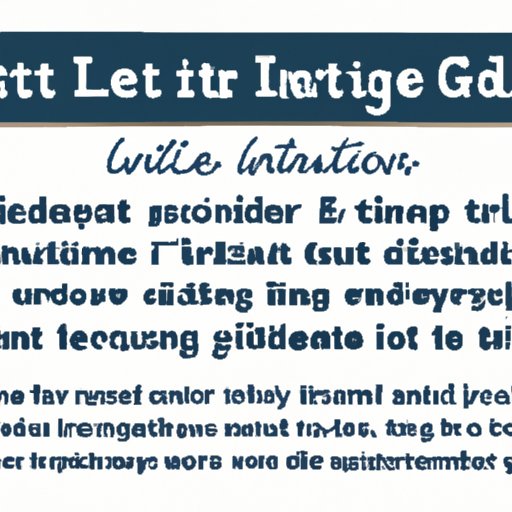
I. Introduction
A letter of intent is a powerful tool that can help you achieve your goals. Whether you’re applying for a job, seeking funding for a project, or looking to establish a partnership, a well-written letter of intent can make all the difference. In this article, we’ll explore how to write an effective letter of intent. We’ll cover everything from the basics to advanced techniques, giving you the tools you need to succeed.
II. Step-by-Step Guide
Writing a letter of intent can be daunting, especially if you’ve never done it before. The first step is to understand what a letter of intent is and what it should include. Generally, a letter of intent should have the following components:
- Opening statements: Introduce yourself and state the purpose of the letter.
- Goals: Explain what you hope to achieve and why it’s important.
- Qualifications: Highlight your credentials and why you’re the best fit for the opportunity.
- Achievements: Provide examples of your past successes and how they’re relevant to the current opportunity.
- Closing statements: Summarize your key points and express your enthusiasm for the opportunity.
To write an effective letter of intent, follow these steps:
- Start with a strong opening sentence that captures the reader’s attention.
- Clearly state your purpose and what you hope to achieve.
- Explain why you’re the best fit for the opportunity and provide examples of your qualifications and achievements.
- Show enthusiasm for the opportunity and express your willingness to move forward.
Here are some additional tips to help you write an effective letter of intent:
- Use clear and concise language.
- Focus on what you can offer.
- Emphasize your strengths and unique qualities.
- Provide specific examples and evidence of your accomplishments.
Here’s an example of how to write a strong opening statement:
“I am excited to submit my letter of intent for the XYZ position at ABC Company. As a highly skilled and experienced professional in the field, I believe I have the qualifications and expertise to succeed in this role.”
III. From Research to Writing
Conducting research is an important first step in writing a letter of intent. Before you start writing, make sure you understand the purpose of the letter, the target audience, and the appropriate tone.
When conducting research, consider the following:
- What is the purpose of the letter of intent?
- Who is the target audience?
- What tone is appropriate for the situation?
Once you have a clear understanding of these components, you can start writing your letter of intent. Here are some additional tips:
- Address the letter to a specific person if possible.
- Use a friendly, professional tone throughout.
- Provide context for your qualifications and achievements.
- Draw connections between your past experience and the current opportunity.
IV. Real-World Examples
One of the best ways to learn how to write a strong letter of intent is to study real-world examples. Here are a few examples of successful letters of intent:
- A letter of intent for a job that clearly highlights the candidate’s qualifications and fit for the position.
- A letter of intent for funding that clearly states the project’s goals and how they align with the funder’s values.
- A letter of intent for a partnership that clearly highlights the benefits to both parties and outlines the terms of the agreement.
When studying these examples, pay attention to what makes them effective. Is the language clear and concise? Are the qualifications and achievements relevant to the opportunity? By understanding what works in successful letters of intent, you can apply these principles to your own writing.
V. Common Mistakes to Avoid
Even the most talented writers can make mistakes when writing a letter of intent. Some of the most common mistakes include:
- Using vague or overly complex language.
- Focusing too much on the writer’s needs rather than the reader’s needs.
- Not providing enough context for qualifications and achievements.
- Overstating accomplishments or using inflated language.
To avoid these pitfalls, focus on clear, concise language, and demonstrate how your qualifications and achievements are relevant to the opportunity at hand.
VI. Tailoring Your Message
When writing a letter of intent, it’s important to consider the audience and tailor your message accordingly. Depending on who you’re writing to, the language, tone, and content of your letter should change.
Here are some examples of different audiences and how to tailor your message to them:
- Employers: Focus on your qualifications and how they align with the job’s requirements.
- Funders: Emphasize the goals and objectives of your project and how they align with the funder’s values.
- Partners: Highlight the benefits of the partnership to both parties and outline the terms of the agreement.
By understanding your audience and tailoring your message, you can increase the effectiveness of your letter of intent.
VII. Taking a Stand
A letter of intent can be more than just a summary of your qualifications and achievements; it can also be an opportunity to take a stand on a relevant issue or topic. Taking a clear position in your letter can make it more persuasive and memorable.
Here are some tips for structuring your argument:
- Start with a strong opening statement that clearly states your position.
- Provide evidence to support your position. This could be statistics, research, or personal anecdotes.
- Anticipate counterarguments and address them in your letter.
VIII. Conclusion
Writing a letter of intent can be challenging, but with the right tools, you can create a compelling message that helps you achieve your goals. By following these tips and examples, you can write with confidence and avoid common pitfalls. Remember to tailor your message to your audience, focus on clear and concise language, and take a stand when appropriate. With these techniques, you can create a letter of intent that stands out from the rest.




